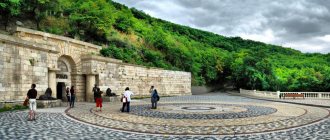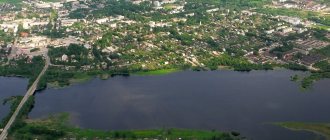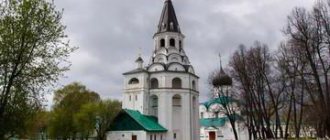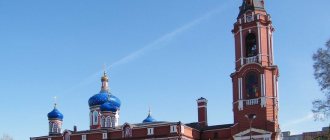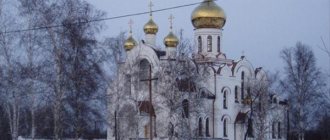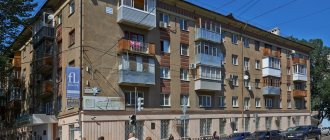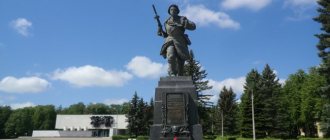The city of Kaliningrad (formerly Koenigsberg) occupies the position of a semi-exclave in relation to the Russian Federation: they do not have a common border. The region neighbors Lithuania and Poland and has direct access to the ice-free Baltic Sea. This convenient location allows the city area to have sustainable development. In recent years, Kaliningrad has been recognized several times as the best Russian city.
Königsberg Castle (“royal mountain”), which arose in the second half of the 13th century, is closely connected with the history of the knights of the Teutonic Order. It was they who moved their capital here from Poland. And then they contributed to the development of the Duchy of Prussia, where power belonged entirely to the church hierarchy. Cities flourished around the fortress:
- Altstadt
- Lebenicht
- Kneiphof
They were destined to unite with Koenigsberg, which became the capital of the Prussian state in 1724. A few years later, the capital of Prussia briefly became a Russian city as a result of the defeat of the “Prussians” by Russian troops in the Seven Years’ War.
Historians tend to assess the four-year period of Russian rule as positive for the development of the city. The industrialization of Koenigsberg began later, when woodworking and shipbuilding began to develop.
By the beginning of the First World War, the city had become a major international trading port and at the same time was a German exclave after Germany's defeat in the war. It was separated from the country by the Polish corridor. This affected the development of the territory: Koenigsberg was the most backward German city due to its distance from Germany. This is how he entered the Second World War.
In 1944, British aircraft destroyed the central part of the city, historical monuments and thousands of civilians were damaged. In April 1945, Soviet troops under the command of Marshal Vasilevsky successfully completed the assault on Koenigsberg, achieving the complete surrender of German troops.
The future fate of the Prussian city was finally decided after the complete victory of the Soviet troops - according to the Potsdam decision, part of the Prussian lands, along with Koenigsberg, went to the Soviet Union, and in July 1946 the city was renamed Kaliningrad and became the center of the region of the same name. A new era began in the history of the ancient Prussian city.
City of Kaliningrad
Kaliningrad is a city in western Russia and the administrative center of the Kaliningrad region, located on the shores of the Baltic Sea on the Pregolya River. In the past it was known as the city of Königsberg - the capital of East Prussia and one of the most important centers of the Baltic. Kaliningrad has a rich history and a unique flavor for Russia, full of sights and architectural monuments. Even though the city lost its historical appearance during the Second World War, it retained the “atmosphere of old Europe.”
Kaliningrad is the westernmost administrative center of Russia, which for most of its history was one of the most important cities in Prussia, so it stands out historically and culturally for its “European” mentality. Unfortunately, the Second World War practically destroyed the architecture of old Königsberg, leaving very little of its former beauty. Architecturally, today's Kaliningrad is a mixture of late German buildings and buildings predominantly from the Soviet period.
Despite all this, Kaliningrad has several unique attractions: Kant Island, where an impressive medieval cathedral is located, a silent witness to the centuries-old history of the city, near the walls of which the great German philosopher rests, several beautiful neo-Gothic city gates, ancient German churches and small surviving quarters of historical buildings. Kaliningrad is also an excellent starting point for visiting the famous Baltic beaches and other interesting places in the Kaliningrad region.
The first years of Kaliningrad as part of the USSR
By the time Kaliningrad officially became part of the USSR, it could hardly be called German. At the beginning of the war, 370 thousand citizens lived in it. But by the time the city was captured by Soviet troops, only 20 thousand Germans remained in it. Many by this time had either fled the city or died as a result of British bombing.
During the war, many monuments and buildings that represented the greatness of German architecture were destroyed. The Soviet authorities almost immediately set a course for restoring the city:
- Transport links were resumed. Already in the fall of 1946, the first tram was put on rails in Kaliningrad;
- Technical schools and other educational institutions were opened to train specialists;
- Important cultural facilities have reopened, including cinemas and museums.
A separate question was what to do with the Germans remaining in the city. At first, the Soviet authorities decided to adapt them to new living conditions. A newspaper was published for them in their native language, and several schools were opened with teaching in German.
In 1947, it was decided to deport most of the indigenous people to Germany. Instead, Kaliningrad began to be populated by Soviet citizens. Only a few German specialists remained in the city who participated in the restoration of industrial enterprises. By 1949, they had completed their tasks and were also deported to Germany.
Might be interesting:
Moscow
Saint Petersburg
Krasnodar
Kazan
all cities
Geography and climate
Kaliningrad is located on the Pregolya River at its confluence with the Kaliningrad Bay of the Baltic Sea. The city is the capital of the westernmost administrative-territorial unit of Russia - the Kaliningrad region, located between Poland (Gdansk) and Lithuania (Klaipeda). The distance from Kaliningrad to Moscow is approximately 1300 km.
Winter in Kaliningrad
The climate of Kaliningrad is transitional from maritime to continental. It is characterized by relatively high humidity and unpredictable weather, typical of most Baltic cities. Summers in Kaliningrad are usually cool, and winters are mild with slight frosts and unstable snow cover.
Kaliningrad region
Geographical position
The Kaliningrad region is the extreme western region of the Russian Federation and does not have common borders with other constituent entities of the country.
The Kaliningrad region is separated from the main part of Russia by Lithuania, Latvia and Belarus, the region also borders on Poland, and the western coast faces the Baltic Sea. The length of the region's borders is 540 km, of which 210 km fall on Poland, 200 km on Lithuania, and the remaining 130 km on the sea. Geographically, the Kaliningrad region belongs to Central Europe and is a structural part of the Northwestern Federal District of Russia. From west to east the region stretches for 205 km, and from north to south – for 108 km. The area of the territory is 13.3 thousand km2, and taking into account the water areas of the Kaliningrad and Curonian Lagoons of the Baltic Sea it increases to 15.1 thousand km2.
The administrative center of the region is the city of Kaliningrad, or former Koenigsberg, two hours ahead of Greenwich time. The time difference with Moscow is one hour. The transition to winter time is not carried out, as in all other regions of Russia.
Relief
The main relief structures of the Kaliningrad region are hilly plains and lowlands, some areas of which are below sea level. The region's territory is the western edge of the vast East European Lowland, its geological forms are part of the Baltic Basin. A significant area is occupied by the Pregol-Instruchskaya lowland plain, located at an altitude of no more than 50 m above sea level, from the south it is bordered by the Baltic ridges, which are low hills, and in the north the Primorskaya Lowland approaches the sea. The highest point of the relief, reaching 240 m, is located in the east of the region, where the Vishtynets Upland is located. Negative heights can be observed on the coast of the Curonian Lagoon, these are the so-called polders - areas of territory fenced off from the sea by dams.
The external appearance of the relief of the Kaliningrad region was formed under the influence of the last Valdai glacier, sliding down to the sea from the Scandinavian mountains. As the glacier flowed, it leveled the territory and formed vast basins characterized by high humidity and an abundance of marshy areas. The average absolute height of the area is 15 m above sea level, relative heights rarely exceed 20 m. A significant area of the Kaliningrad region is occupied by reclamation canals and artificially drained areas.
The Kaliningrad region is not one of the regions very rich in minerals, but its main asset is its amber deposits. 90% of the world's amber reserves are located in the region and in certain areas of the sea shelf. In addition to amber, phosphorites, peat, brown coal, rock salt, titanium, zirconium and manganese ores are mined. In the depths of the region there are small deposits of oil and mineral waters.
Climate
The climate of the Kaliningrad region, closer to the coast of the Baltic Sea, is typically maritime; to the east, inland, it changes to temperate continental. It is warmer near the sea, the average annual temperature on the coast is 7.5°C, in the northern and western parts of the region it is slightly lower, approximately 6.5°C. The coldest month is January, the average air temperature in the winter season is 4°C with a minus sign, the minimum reaches -23°C. The warmest month is July; in summer, the average air temperature is +18°C, the maximum exceeds +26°C.
Due to the proximity of the sea, the climate is damp, winters are much warmer and milder than in the continental regions of Russia. Severe frosts occur very rarely, the snow cover is thin, and when it falls, it does not remain for a long time and melts quickly. Summer is cloudy and rainy, hot days with plenty of sun are rare. It rains on average 185 days during the year, with most of it falling in summer and autumn, but you can enjoy fine days only 68 times a year. There is stable snow cover for about 55 days. The average annual precipitation in the region ranges from 600 to 750 mm. In autumn, cyclones from the sea approach the region, bringing stormy winds and thunderstorms. Droughts are common in spring. The climate of Kaliningrad is characterized by an average annual air temperature of +7.9°C, precipitation with a norm of 820-840 millimeters.
Hydrography
The Kaliningrad region is distinguished by its wealth of water resources; the territory is cut by valleys of large and small rivers belonging to the Baltic Sea basin. In total, the region is crossed by 148 rivers, the largest watercourses are the Neman and Pregolya, the remaining rivers are their tributaries. The Neman, originating on the slopes of the Minsk Upland in Belarus, has two tributaries within the boundaries of the region - Sheshupe and Tylzha, flows into the Curonian Lagoon, forming a delta with many islands. The Pregolya is the longest watercourse within the region, it has four tributaries - Pissa, Instruch, Lava, Angrapa, and flows into the Kaliningrad Bay. Both large rivers are connected by a canal.
On the territory of the region there are many small rivers and streams, the length of which does not exceed 10 km, some of them do not flow into the Neman or Pregolya basins, but flow directly into the sea. The Rzhevka River and its tributaries flow into the Curonian Lagoon, and the Prokhladnaya River with its numerous tributaries flows into the Kaliningrad Bay. The network of watercourses is very dense; there are about 4,500 streams within the region alone. The total length of all rivers in the region is 13 thousand km, of which 70% are small rivers and streams.
The rivers have a mixed supply, 40% of the annual flow is replenished by melted snow water, 35% by rain, 25% by groundwater. In the spring, when the snow melts, there is high water; in summer and winter, when watercourses are fed mainly by groundwater, there is low water. The ice regime is unstable, the thickness of the ice cover on rivers varies from year to year: in cold winters it reaches 70 cm, and if the winter is mild, it does not exceed 15 cm, or even does not form at all.
The only large body of water in the Kaliningrad region is Lake Vishtynetskoe, located on the border with Lithuania, with an area of 16.6 km2. The remaining 38 reservoirs are very small, including both natural lakes and oxbow lakes, as well as artificial ponds and reservoirs formed at hydroelectric power stations or on the site of former quarries. The Kaliningrad and Curonian Lagoons can also be called inland bodies of water - estuaries, since they are separated from the sea by spits, and the water in them is fresh.
Vegetable world
Geographically, the Kaliningrad region is included in the zone of broad-leaved forests, but they were completely cut down two centuries ago. Their place was taken by artificially planted mixed and coniferous forests, in which spruce, pine, birch, maple, beech, ash and linden trees predominate, with occasional areas of oak forests. Of particular ecological value is the unique grove of black alder, as well as the so-called Red Forest, where rare plant species grow. The region is provided with forests by 18.5%; the eastern territory is characterized by the greatest forest cover.
The Kaliningrad region is replete with marshy areas. The total area of swamps in the region reaches 1000 km2, and their flora is surprisingly rich and diverse. In addition to the usual mosses, lichens, berries and mushrooms, irises, lilies and other rare plants that are under protection grow in the swamps.
Animal world
The fauna of the Kaliningrad region is distinguished by great diversity. The region is permanently home to about 340 species of terrestrial vertebrates, more than 320 species of birds, and more than 50 species of fish are found in the bays of the Baltic Sea. 45% of the vertebrate fauna, including 21 species of mammals, 111 species of birds, 4 species of amphibians, 12 species of fish, are rare and are under protection. Birds from Northern Europe migrate annually through the Kaliningrad region for wintering.
Among the ungulates, the region is inhabited by elk, large herds of roe deer and red deer, fallow deer, and sometimes sika deer and wild boar enter the territory. There are many small fur-bearing predators in the forests - martens, foxes, ferrets, weasels, and stoats. But wolves in the region were completely exterminated by the end of the 20th century. Among rodents, squirrels, beavers and muskrats are ubiquitous. Birds are mainly represented by passerines: starlings, finches, bramblings, warblers, warblers. In the forest thickets you can find hazel grouse and black grouse, in the meadows - partridges and storks, in the rivers and swamps - wild geese, ducks, cranes and waders. Birds of prey include hawks, owls, eagle owls, and owls.
History of the Kaliningrad region
The history of the region dates back to the beginning of the 13th century, when the Teutons decided to seize Prussian lands along the shores of the Baltic Sea and conquer pagan tribes. Having won the victory, on the site of the destroyed pagan temple, the crusaders erected a wooden fortress, which they called the Royal Mountain, or Koenigsberg. Gradually, the area around the citadel was built up with German villages and monasteries. The city grew and developed; in the mid-15th century, the Teutonic Order founded the Prussian Duchy and made the fortress its capital.
In 1807, the city was captured by the Napoleonic army, the region came under French rule, but not for long - in 1813 it was liberated by Russian troops. The second half of the 19th century was a calm and productive time, Königsberg was renovating and expanding. In 1918, on November 28, a popular uprising broke out, the Königsberg magistrate was forced to resign, and power was transferred to the Council of Workers' and Soldiers' Deputies. But already on March 3, 1919, the uprising was brutally suppressed by government troops, although this could not restore royal power.
Koenigsberg suffered heavy losses and destruction during World War II. Already in 1941, the city was actively bombed by Soviet pilots. And in April 1945, during an assault operation by Russian troops, its streets were turned into ruins. The city announced its capitulation on April 9. At the Potsdam Conference, it was decided to transfer Koenigsberg and the surrounding lands to the USSR, so the city acquired a new name - Kaliningrad. In the post-war period, the city and region were actually repopulated and restored at an accelerated pace. Nowadays Kaliningrad is a major port and military hub, where the headquarters of the Russian Baltic Fleet is located.
Population of the Kaliningrad region
The population of the Kaliningrad region is about 980 thousand people, of which 78% are urban residents. According to the population census conducted in 2010, Russians predominate among the residents of the region - 86%. A significantly smaller percentage of the population is occupied by Ukrainians, Belarusians, Lithuanians, Armenians, and Germans. There are several Tatar, Jewish and Gypsy communities. The majority of the population adheres to the Orthodox religion, although there are quite a few Catholic and Lutheran parishes. There are Jewish temples and Muslim mosques, Baptist and Jehovah's sects.
Economy
There are more than 6,000 enterprises in the Kaliningrad region, the vast majority of which are in the mining industry - about 5,700. 120 companies are engaged in the extraction of fossil raw materials, about 200 enterprises produce and distribute gas and water, electrical and thermal energy. The most developed industries are woodworking, electrical engineering production, furniture production, and the food industry. There are plans to create three powerful industrial parks.
Among the branches of the food industry, fish farming and the production of fish products are the most developed. The largest fishing ports are located in Kaliningrad, the villages of Pionersky and Svetly. Kaliningrad companies mainly specialize in the production of canned and semi-finished products from sea fish and caviar.
Main energy. It consists of four thermal power plants, the newest and largest of which is Kaliningrad CHPP-2 with a capacity of 450 MW, a state district power station and two hydroelectric power stations, as well as about 10 thousand gasoline and diesel thermal power plants with a total capacity of up to 30 MW. Alternative energy is actively developing in the region. The Zelenograd wind power plant, the largest wind farm in Russia, operates in the region. To generate thermal energy, mainly oil derivatives, natural gas, and coal are used. The Kaliningrad region is fully self-sufficient in energy.
Tourism
Tourism is one of the priority areas of the region's economy. Tourists are attracted by the healing climate of the Baltic Sea, mineral waters and mud, beautiful freshwater bays with sandy beaches and spits, picturesque lakes and rivers. The main centers of tourism and balneological resorts are the cities of Svetlogorsk and Zelenogradsk. Travelers are also attracted by the abundance of historical monuments and attractions of Sovetsk, Tilsit, Gusev, Pravdinsk. Equestrian sports enthusiasts visit Chernyakhovsk, where the largest stud farm in Russia is located. On the large rivers of the region you can ride kayaks, canoes, yachts or boats.
Story
Around the 10th century, the settlement of Tvangste was founded at the mouth of the Pregolya River to protect the waterways. The year of foundation of the city is considered to be 1255, when the Teutonic knights founded a castle on the site of this Prussian settlement, named Königsberg or Krolevets (in Polish). By the end of the 13th century, a new settlement had grown up around the castle and was granted city rights.
Interestingly, other settlements began to form around the castle - Löbenicht and Kneiphof (now Kant Island), which also received city rights. Later, they united into one city, which they called Königsberg. At the same time, the original Königsberg began to be called simply Altstadt.
Center of Kaliningrad
In the first half of the 14th century, construction of a cathedral began on the island of Kneiphof. In the 15th century, the capital of the Teutonic Order was moved to Königsberg from Marienburg (now Malbork in Poland). In 1466, the city became the capital of the Prussian Duchy as part of the Polish kingdom. Königsberg was also part of the Hanseatic League.
Koenigsberg was the center of science and culture in Germany, Poland and Lithuania. In 1724, Immanuel Kant, one of the most famous German philosophers, who lived in this city all his life, was born here. In 1776, the famous writer Amadeus Hoffmann was also born in Königsberg.
Königsberg was part of Poland until 1657. In 1758, the city was taken by Russian troops and for some time belonged to the Russian Empire, until Peter III returned it to Prussia. In the 19th century, Königsberg quickly grew and developed, becoming one of the centers of Germany. In 1919, one of the first airports in Europe was built here.
Fishing village and Kanta island
Unfortunately, historic Königsberg was practically destroyed during the Second World War. In 1944, the city was first bombed by British aircraft, and then severely damaged as a result of a heavy assault by Soviet troops. At the same time, many iconic sights of Königsberg were destroyed, including the ancient castle. In 1946, the city was renamed Kaliningrad in honor of the famous communist figure Mikhail Kalinin.
Education
There are more than 180 municipal educational institutions in Kaliningrad:
- Preschool educational institutions
- Secondary schools
- Children's institutions of additional education (art, music schools)
- Teen clubs
- Sports schools
- Private and non-state educational institutions.
There are 21 higher education institutions providing education in the city. The most famous of them:
- Immanuel Kant Baltic University
- Baltic Academy of Fishing Fleet
- Higher Marine Engineering School
- Baltic Naval Institute
- Kaliningrad Border Institute
A branch network of secondary specialized educational institutions has been developed. Some of them operate on the basis of industry universities.
How to get there
Kaliningrad has an airport, which is located 16 km northeast of the city. From the airport to the center you can take bus 144 or taxi. Kaliningrad is connected by air to Moscow, St. Petersburg, Kazan, Minsk, Warsaw and some other cities.
Baltic Sea
You can get to Kaliningrad by train from Moscow, St. Petersburg, Vilnius, Sochi, and by bus from Tallinn, Riga, Kiel, Lubeck, Gdansk, Pärnu, Berlin and Szczecin.
Ecology of Kaliningrad
The main sources of air pollution within the city are transport. In terms of availability of personal passenger transport, Kaliningrad ranks 5th in the Russian Federation. There are almost 350 vehicles per thousand inhabitants. The most unfavorable streets in the city in terms of nitrogen oxide content:
- Gorkogo Street
- Dzerzhinsky Street
- Victory Avenue
- Peace Avenue
- Sovetsky Prospekt
- Leninsky Prospekt
With changes in traffic flows and their redistribution from the central part of the city, the environment has been significantly improved.
Leningradsky is considered the best area to live, where new residential complexes are located in green areas.
Attractions
The main attraction of modern Kaliningrad is the cathedral and Kant Island. In addition, here you can see several magnificent ancient gates and German churches. In Soviet times, Kaliningrad was built up with typical high-rise buildings, with surviving fragments of historical buildings adjacent to them. Significant areas of pre-war German architecture have been preserved only in Amalienau, Ratshof and Maraunenhof (in fact, these are suburbs of Königsberg, where cottages of wealthy citizens were built in the 19th and early 20th centuries).
Kant Island (Kneiphof)
Kant Island
Kant Island or Kneiphof is one of the oldest places in Kaliningrad. In the Middle Ages, a settlement arose here, which soon received city rights, and then became part of Königsberg. The island now houses the city's most iconic landmark, the cathedral. The grave of the famous philosopher Immanuel Kant is also located here.
Once upon a time this island, formed by the Pregolya branches, was the real heart of Königsberg. Kneiphof was the spiritual and commercial center of the city, built up with three hundred houses. The island was connected to the rest of Königsberg by five bridges. Kneiphof was destroyed in 1944 by British air raids. After Kaliningrad became part of the USSR, the ruins of buildings were removed to rebuild Leningrad.
Cathedral
The Cathedral is a symbol of modern Kaliningrad. It was built in the 14th century in the brick Gothic style. It was originally a Catholic Church, which became Lutheran after the Reformation. Currently, the cathedral is not a functioning religious building and is used for museum exhibitions and concerts. Unfortunately, the rich interior of the church was destroyed by bombing. But the building itself survived. During Soviet times, the cathedral was in a deplorable state and was completely restored only in the 2000s.
Many believe that the cathedral was preserved only thanks to Kant’s grave. Kant's works were highly appreciated by Lenin. Therefore, during Soviet times, the ruins of the ancient church, located next to the grave of the great philosopher, were decided to be left alone.
The first cathedral in Königsberg was built by 1302 and was located in the southwestern part of Altstadt. Very quickly it became too small for the growing city. Ultimately, the Master of the Teutonic Order allocated a site for the construction of a new cathedral on the island of Kneiphof. And in 1333 construction began. The building material for the new church building was brick obtained from the demolition of the old cathedral. Also for the construction, new gates were made within the walls of Alstadt and a temporary bridge was built. Interestingly, the Cathedral Gate eventually stood for 6 centuries and was destroyed by bombing in 1944. The new cathedral was completed in 1380.
Opposite Kant Island, on the banks of the Pregolya, there is the “Fish Village” - a modern complex of buildings in the style of traditional German architecture. This stylized “piece” of old Königsberg is now a popular attraction in Kaliningrad.
Königsberg city gate
In Kaliningrad, 7 city gates have survived to this day. All of them were built in the 19th century and are now important architectural monuments.
Brandenburg Gate
The Brandenburg Gate was built in the 17th century on the road leading to Brandenburg Castle. The current building, in brick neo-Gothic style, dates from the first half of the 19th century and is located on the border of the historic district of Haberberg. The gate is still used for its intended purpose.
Royal Gate
The Royal Gate was built in Kaliningrad in the 19th century on the site of the medieval Kalthof Gate, which was demolished in the first half of the 18th century. They resemble a small castle and are a striking example of neo-Gothic architecture. The Royal Gate is decorated with bas-reliefs of King Otakar II of Bohemia (left), King Frederick I of Prussia (center) and Duke of Prussia Albrecht I (right), installed in three niches. Nowadays a branch of the Museum of the World Ocean is located here.
Friedland Gate
Friedland Gate is another brick neo-Gothic landmark of Kaliningrad, dating back to the 19th century. Nowadays the museum of old Königsberg is located here.
Rossgarten Gate
The Rossgarten Gate was built in the second half of the 19th century on the site of the first fortified ramparts of Königsberg, dating back to the 17th century. They have beautiful battlements and small neat turrets. Now there is a restaurant here.
Friedrichsburg Gate
The Friedrichsburg Gate is a powerful fortification built in 1852 in the neo-Gothic style. Now within these walls there is a branch of the Museum of the World Ocean.
Sackheim Gate
The Sackheim Gate was built in the mid-19th century and for some time served as a checkpoint at the entrance to the city. Moreover, the first gate on this site was erected back in the 17th century and was part of the old fortified ramparts.
Don Tower
The Don Tower is part of the surviving 19th century fortifications that houses the Amber Museum. This powerful fortification forms a single architectural ensemble with the Rossgarten Gate. During the assault on Königsberg, the garrison of this tower was the last to surrender.
Churches of Kaliningrad
Cathedral of Christ the Savior
Cathedral of Christ the Savior is an Orthodox cathedral, which is the architectural dominant of Victory Square. The temple was consecrated in 2006 and built in the traditional Russian-Byzantine style. It is topped with six domes and a belfry.
Juditten
Juditten is a Gothic church founded in the second half of the 13th century by the Teutonic Knights. This is the oldest (surviving) building in Kaliningrad. Now it is part of an Orthodox convent.
Queen Louise Memorial Church
The former Church of Queen Louise is a neo-Romanesque historical building with Art Nouveau elements, built at the beginning of the 20th century. Originally there was a Lutheran church here. Nowadays there is a puppet theater within its walls.
Ponart
Ponart is a neo-Gothic brick church built at the end of the 19th century. Since 1992 it has been an Orthodox Church of the Nativity of the Blessed Virgin Mary.
Former Church of the Holy Family
The former Church of the Holy Family is a beautiful neo-Gothic building built at the beginning of the 20th century according to the design of Friedrich Heitmann. In 1945, the church was seriously damaged and was practically in ruins until the 80s of the 20th century. Restored in 1982 as the city philharmonic.
Holy Cross Cathedral
Holy Cross Cathedral is an Orthodox church located in the building of a former Lutheran church. This Art Nouveau building was built in the 40s of the 20th century.
Church of St. Adalbert
St. Adalbert's Church is a small neo-Gothic chapel built at the beginning of the 20th century in Amalienau. Now there is an administrative building here, which belongs to the Institute of Terrestrial Magnetism
Other sights and interesting places in Kaliningrad
Victory Square
Victory Square is one of the central squares of Kaliningrad, which was previously called Hanseatic. Until the beginning of the 20th century, city fortifications were located in its place.
For tourists with children, the local zoo is a great place to visit. The zoo in Kaliningrad is one of the oldest and largest in Russia. It was founded in the 19th century. There are more than 300 species of animals here. For botany lovers, we recommend going to the botanical garden, where 2,500 species of plants from various places on the planet are collected.
Königsberg Stock Exchange
Königsberg Stock Exchange is one of the most beautiful civil buildings of modern Kaliningrad, built on the banks of the Pregolya in the second half of the 19th century in the neo-Renaissance style.
The Curonian Spit is one of the most beautiful natural attractions of the Kaliningrad region. This narrow strip of land with sand dunes, pine forests and wonderful sea views stretches from Zelenogradsk to Klaipeda, Lithuania.
Synagogue
The New Synagogue is a Jewish religious building built in 2018 on the site of an older 19th-century synagogue that was destroyed during World War II.
Museum of the World Ocean
The Museum of the World Ocean is one of the most interesting museums in Kaliningrad, which is entirely dedicated to the sea. Ships and deep-sea vehicles, equipment and finds recovered from the seabed are presented here.
Amalienau
Amalienau is a former suburb of Königsberg, which before World War II was built up with villas for wealthy citizens. Significant areas of historical buildings have been preserved here to this day. This is one of the most atmospheric places in modern Kaliningrad.
Russia's rights to new territories
After the annexation of Koenigsberg and its surrounding territories to the USSR, the question of the fairness of such a step was not raised. However, some people interested in history and politics sometimes wonder whether Germany has the right to reclaim its lands .
The answer in this case will be negative. Kaliningrad is unlikely to ever become part of Germany again, and there are serious reasons for this:
- Consent of the victorious countries . After the war and the signing of treaties at the Potsdam Conference, the United States and England officially recognized that the USSR legally included Koenigsberg and its surrounding territories. Important historical documents were signed many years ago and revising them today is at least stupid;
- Compensation for losses . It was the USSR that suffered the brunt of the German military machine, which took the lives of millions of Soviet citizens and left dozens of cities in ruins. Therefore, the annexation of new territories can be considered compensation for German aggression;
- Small German population . Less than 1% of the total population of Germans live in Kaliningrad;
- Lack of interest among German politicians and the public . The pedantic Germans recognize the treaties signed during the Potsdam Conference and believe that they have no legal right to claim the lands lost during the war.
Might be interesting:
Smolensk
Pskov
Sochi
Primorsko-Akhtarsk (Russia)
all cities
